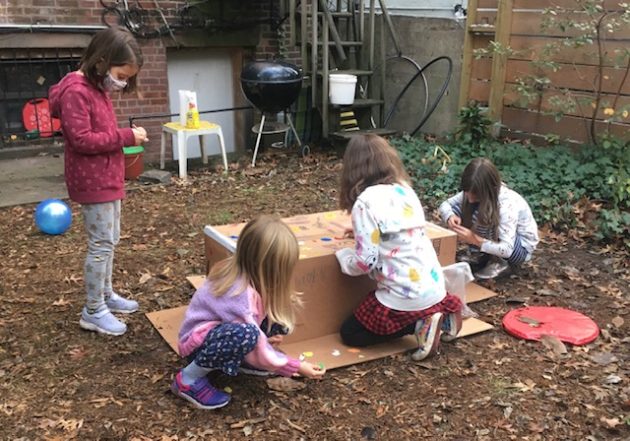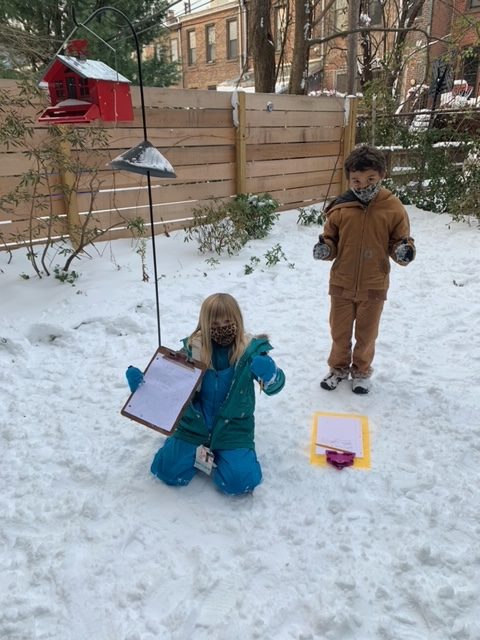
by Arielle Silver-Willner
A Little Backyard Writing School

It’s Friday afternoon and I am in my backyard, setting out plastic cushions six feet apart, disinfecting pencils, and copying my lesson plan onto a dry erase board with multi-colored markers. It’s starting to get cold, but I’m armed with a case of hand warmers and a list of activities that will keep my students moving.
I’m ready for winter.
Before the pandemic hit, I babysat part-time for a few local families. Once schools closed down their in-person learning, one family approached me with an idea: Zoom classes for their second-grader and a few of her classmates; they needed extra help learning to write.
Over the years, I have volunteered with literacy organizations— including a quite strict ESL after school program for second graders in an elementary charter school near my college, and a fun, yet hectic all-age creative writing and academic support program that caters to disadvantaged students from schools across Brooklyn. So I was excited to create my own curriculum––both utilizing teaching the strategies I’d learned and making up new activities. I knew the age group well, but I also knew that ability and interest varies widely, no matter the age—whether because of personality, home support, or developmental differences. My goal from the start was simple—I wanted the kids to write something––anything—and have fun doing it.
Still, I could not ignore a nagging worry that, by charging for my services, I was contributing to the widening education gap that children have experienced during the pandemic. My small group of students would receive an extra hour per week of writing help, while so many children would not, because their parents couldn’t afford it. As a social justice advocate, I felt like a hypocrite, and began to question whether I should agree to this teaching plan after all.
After further consideration, I evolved a few simple solutions. While a tutor with my level of experience might charge anywhere from $40-$150 per hour, I decided to charge just slightly more than my normal babysitting rate. This way, I could make up for some of my lost childcare income and cover supplies. I also decided to offer a sliding scale to any family that needed it.
I began to lead small groups of second-graders in writing and spelling projects over Zoom. The sessions were hectic, experimental, and in many ways, felt like trying to herd kittens. But my goal was being met: the kids were enjoying writing.

One of the motivating factors for the children was social. Unlike the large Zoom lessons with their school classes, where they become frustrated by the chaos of their classmates speaking over each other, in our small group they get the chance to interact with one another and also have an adult provide individual support.
In early fall, the parents, eager to give their children more opportunities to socialize safely, asked to move our writing classes from Zoom into my backyard. We would wear masks, keep our distance, and sanitize our hands frequently, but at least the children could play together. Through experimentation, I expanded my activity repertoire. I made up games and projects that would get the kids running, dancing, playing, and writing.

Here are some crowd-pleasers:
- Group Story: Write the first sentence of a story. Then have your kids take turns adding a sentence until the story is complete. Challenge your kids to be as silly as they can!
- Word Dash: Ask your kids to line up against a wall. Pull a word out of a hat (or in my case, a hollow rubber chicken…); the kids must run across the room/yard and write the word with chalk (or pencil on a piece of paper taped to the wall) as quickly as they can. Make sure to help your children check their spelling after. Then, send them back to the wall for another word.
- Spelling Freeze Dance: Just like freeze dance, but when the music stops, everyone must write down the last word (or sentence, depending on ability level) that they heard. Then spell the word/sentence out loud so your kids can correct their mistakes. The key is to move quickly to keep the kids engaged.
- Description Walk: Have your kids walk around the garden (or house) and choose an item. They must keep their item a secret while writing 2-5 descriptive sentences about it (think about size, shape, color, purpose, etc.). Then ask them to take turns reading their descriptions aloud, so everyone else can guess what it is.
- A/V/N: Mark three areas on the ground with an A (for adjective), V (for verb), and N (for noun)—jump ropes, sticks, or food coloring dribbled in the snow all work. Line your kids up several feet away from these areas and give them a list of words, one at a time. The kids should run to the appropriate area depending on which part of speech they think the word is.
- Word Catch: Stand in a circle and pull a word out of your hat or rubber chicken. Then play catch! Each person must shout the next letter in the word as they throw the ball to the next person. Again, speed is key to help kids keep track of which letter comes next.
I make sure to include at least one physical activity in an hour-long session—and I never ask the kids to sit still for longer than a few minutes at a time. They need time and space to let loose and simply be kids, especially now that they’re so often stuck inside. So do I!
Which is why my backyard classes have felt like such a breath of fresh air—literally—for all of us. With two to four children per session, and no end-goal other than to get my students writing, not only am I seeing academic progress, but the kids are excited to come back. I work with them at their own skill levels, rather than a standardized one, and I love hearing them ask, “Can I do an extra sentence?” It doesn’t hurt that I get to take a break from my computer to run around outside with a bunch of seven-year-olds.
